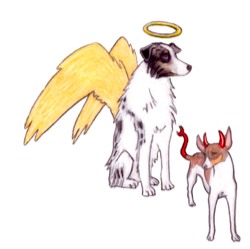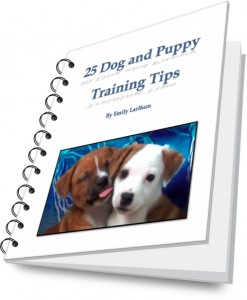 “There are no bad dogs, only dogs that need more guidance and training.”
“There are no bad dogs, only dogs that need more guidance and training.”
by Emily Larlham
I was recently asked, “Well if you don’t use corrections, what do you do when your dog does something you don’t like?” And I was stumped because I could not think of one thing at that moment that my dogs do that I “don’t like”. I then realized that I typically don’t characterize any of my dogs’ behaviors as things I “don’t like” but as things “I need to work on”. So here is a list of the things “I need to work on”: Tug pulls on leash when stressed or over-aroused; my two little dogs jump up on the low table in the living room sometimes; Kiko barks when startled; Trisch finds the presence of new dogs greeting her on a walk punishing and barks if the dogs sniff her face; and when Splash was a puppy she was highly reactive to people and dogs, and even now every once in a while, she will regress and be worried about someone wearing a weird hat or with a weird gait or a tree stump in the forest.
I look at a dog’s behavior objectively. When you do this, you realize that the dog has literally been “set up” to act the way he is acting by the information he has received from the environment, his handler, as well as his genetics and natural doggie behavior. Dogs can only behave like dogs. Instead of being unfair and punishing dogs for thinking and acting like dogs, we can change their behavior by training them.
Behaviors you “like” simply need to be reinforced, while behaviors you find “undesirable” simply need to be prevented from being reinforced. By preventing behaviors from having a reinforcement history you cause them to become “extinct.” You can manage your dog’s environment to prevent the behavior from occurring. You can also train an alternate behavior to replace the undesirable one, reinforce the absence of the undesirable behavior, or interrupt the behavior before it’s reinforced using a positively trained recall, leave it or attention noise. Think in terms of reinforcing the BEHAVIORS you would like to see again, rather than reinforcing your DOG.
You may think that it’s no big deal to tell a dog “No!” or “Eh Eh!” to stop a behavior. The problem with suppressing behavior is that you create a vacuum. The only behaviors with which your dog can replace the one you didn’t like with are more “dog behaviors” and most likely ones you will not be fond of. Another problem is that if the behavior is a side-effect of an underlying problem like stress or over arousal, punishing the symptom can be unfair as well as cause more behavior problems down the line. If you instead get to the root of the problem and fix it using behavior modification, the unwanted problem behavior- which is a side-effect- will disappear on it’s own.
To address Splash’s fear of the strange and Trisch’s dislike of unfamiliar dogs, we use counter conditioning- that is, pairing highly reinforcing things with dogs and people. With Tug, I work on reinforcing calmness on walks to stop the side-effect of pulling when he is over-excited. When both of my little dogs jump on the low table in the living room… well, to be honest, I don’t really care that much, as we never have food on that table. So I could call myself a lazy trainer with regard to that behavior, but I have made sure that they do not jump on the other tables that matter or take food from tables. However, I did train the big dogs not to jump on that same table.
The two main reasons I don’t use physical or psychological intimidation are the following:
1. Regression is a natural part of learning. Just think about learning a new language: we need time to acquire new skills, and some times we will regress and forget what a word means. Imagine being yelled at or punished for forgetting what the word “azul” means in Spanish class. There is no way of avoiding punishment if you do not have a memory that can remember 100% of what you learn.
2. Whether you like it or not, every time you suppress a behavior using physical or psychological intimidation, Classical Conditioning is taking place, and you are conditioning yourself to be associated with something bad that your dog doesn’t like. If you pair yourself with punishment, it becomes harder to compete with other highly reinforcing things in the environment. For example, when your dog is off-leash playing with another dog instead of you. Dogs will stop seeing you as the best option, and perhaps find another dog’s company or chasing animals in the forest more reinforcing than being with you.
Don’t create overly high expectations for your dog. Treat your dog like a dog, a companion, and a friend and you will not be disappointed with their behavior. You can also stop problems before they start by using proactive behavior management.
25 Dog and Puppy Training Tips:
For each month of the year, I will release 2 training tips that will be accessible for free at dogmantics.com. If you simply cannot wait for the information to be published online, and want to support my work, you can buy the collection of all 25 training tips in an ebook format here: 25 Dog and Puppy Training Tips Thank you!
This is a list of all the tips included in the ebook, and that will be eventually available online:
- Teaching a dog previously kept outside to be calm inside the house
- The problem with ignoring unwanted behaviors
- Fading a lure
- Adding a verbal cue or changing a cue
- Dogs and babies
- Socializing tips- Our world can be a scary place!
- What to do if your puppy bites you OUTSIDE of a training session
- Changing your thinking from “I don’t like” to “I need to work on”
- What to use as reinforcement
- Treat deliveries
- Teaching your puppy appropriate greetings on leash
- Teaching “All done” for training sessions and dinnertime manners
- Variety is the spice of life… and training!
- Teaching your puppy to walk off leash
- Don’t let your dog free feed
- Don’t only work on one behavior at a time
- Separation training tips
- Monkey see, monkey do- Take advantage of social facilitation
- Always remember to release your dog!
- The importance of handling
- Chewing
- Teaching “Drop” and “Get it”
- What to do if your puppy sits and refuses to budge on a walk
- Generalizing
- Training your dog to do absolutely… NOTHING!
